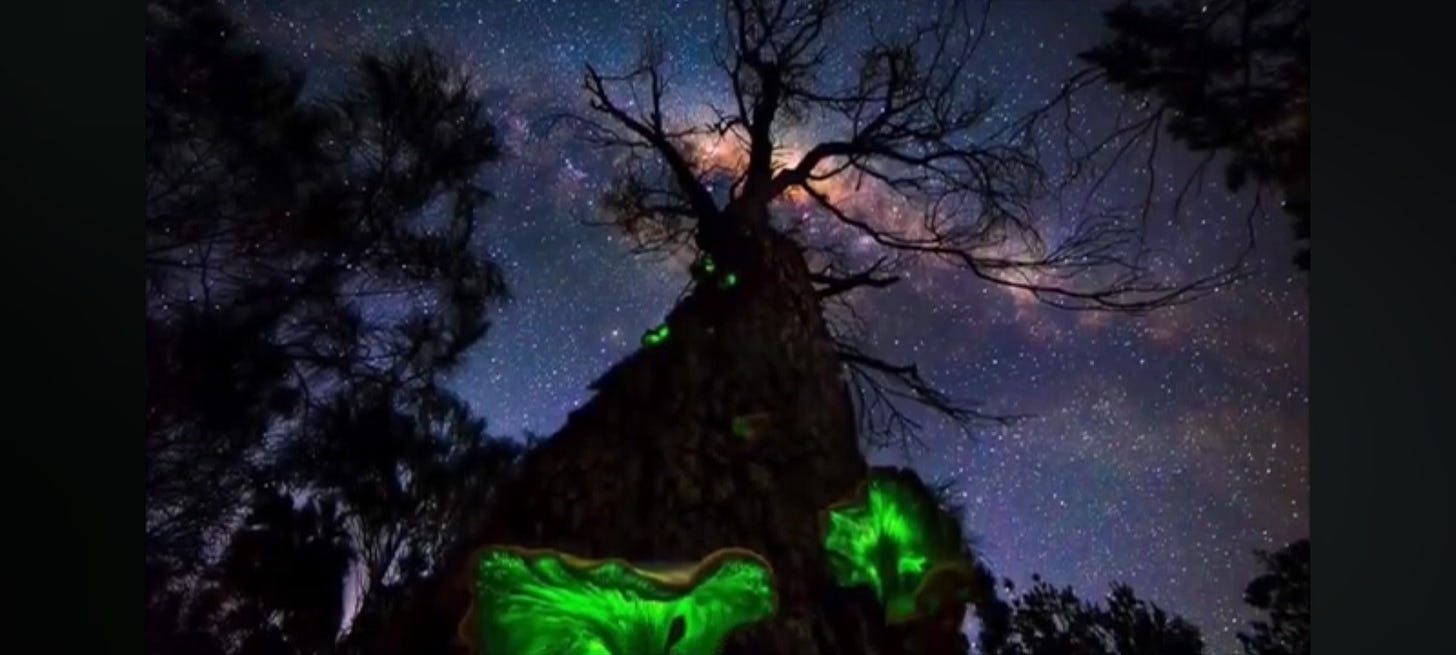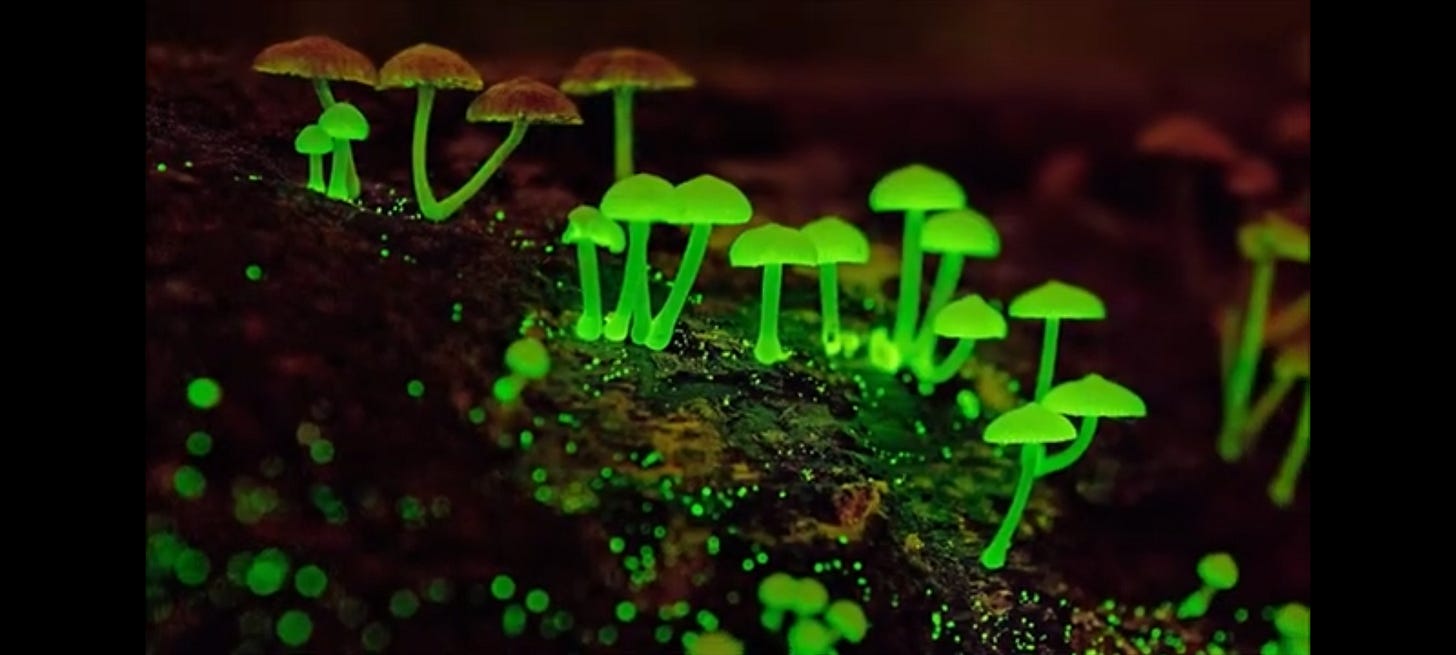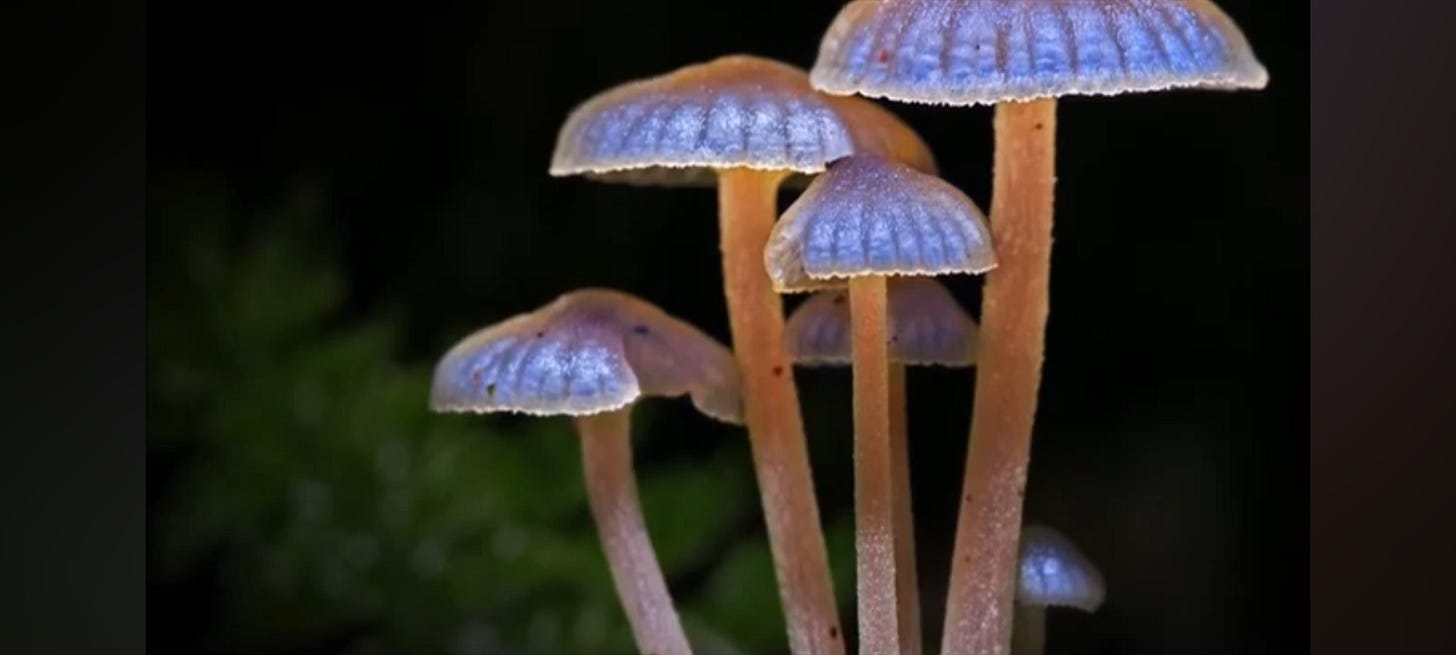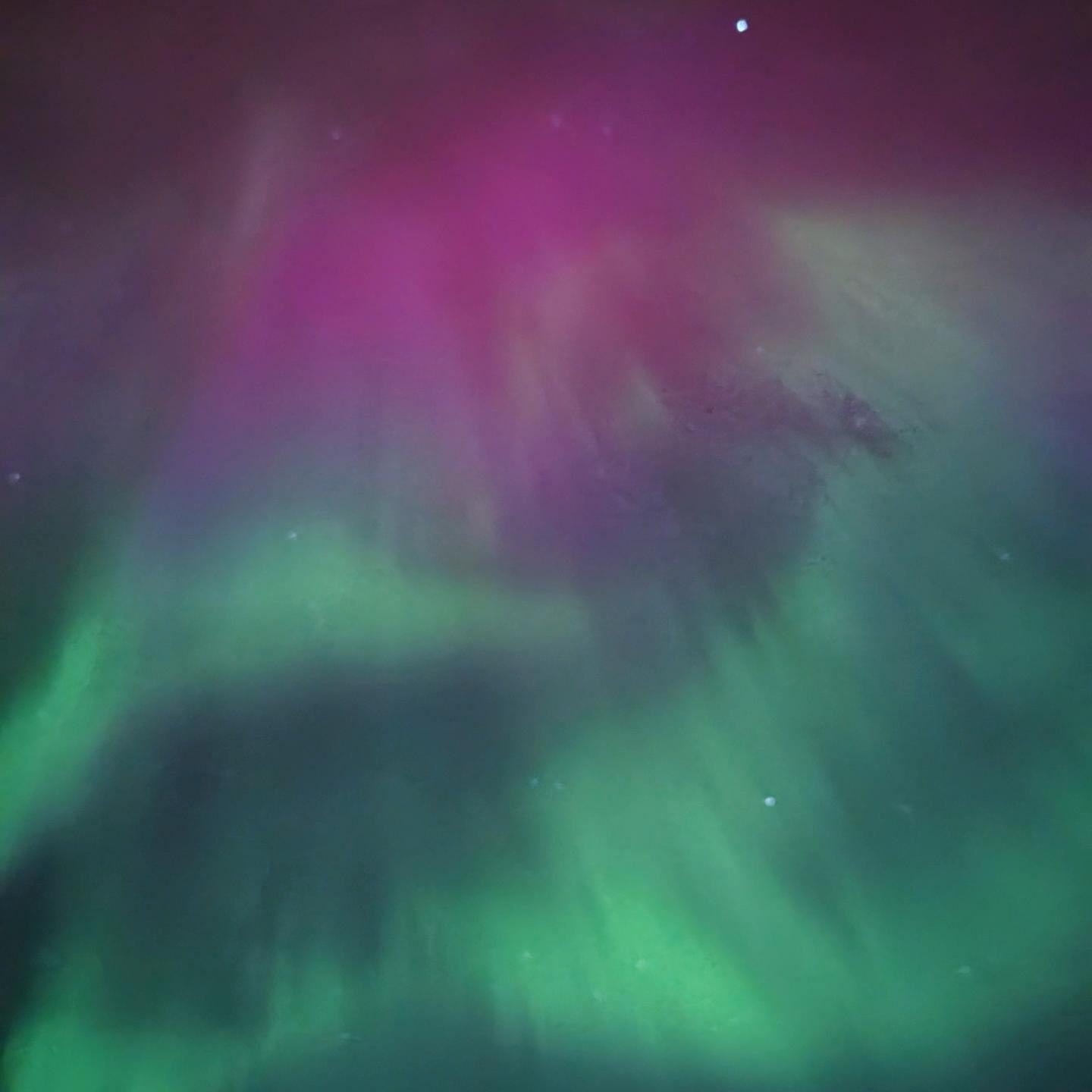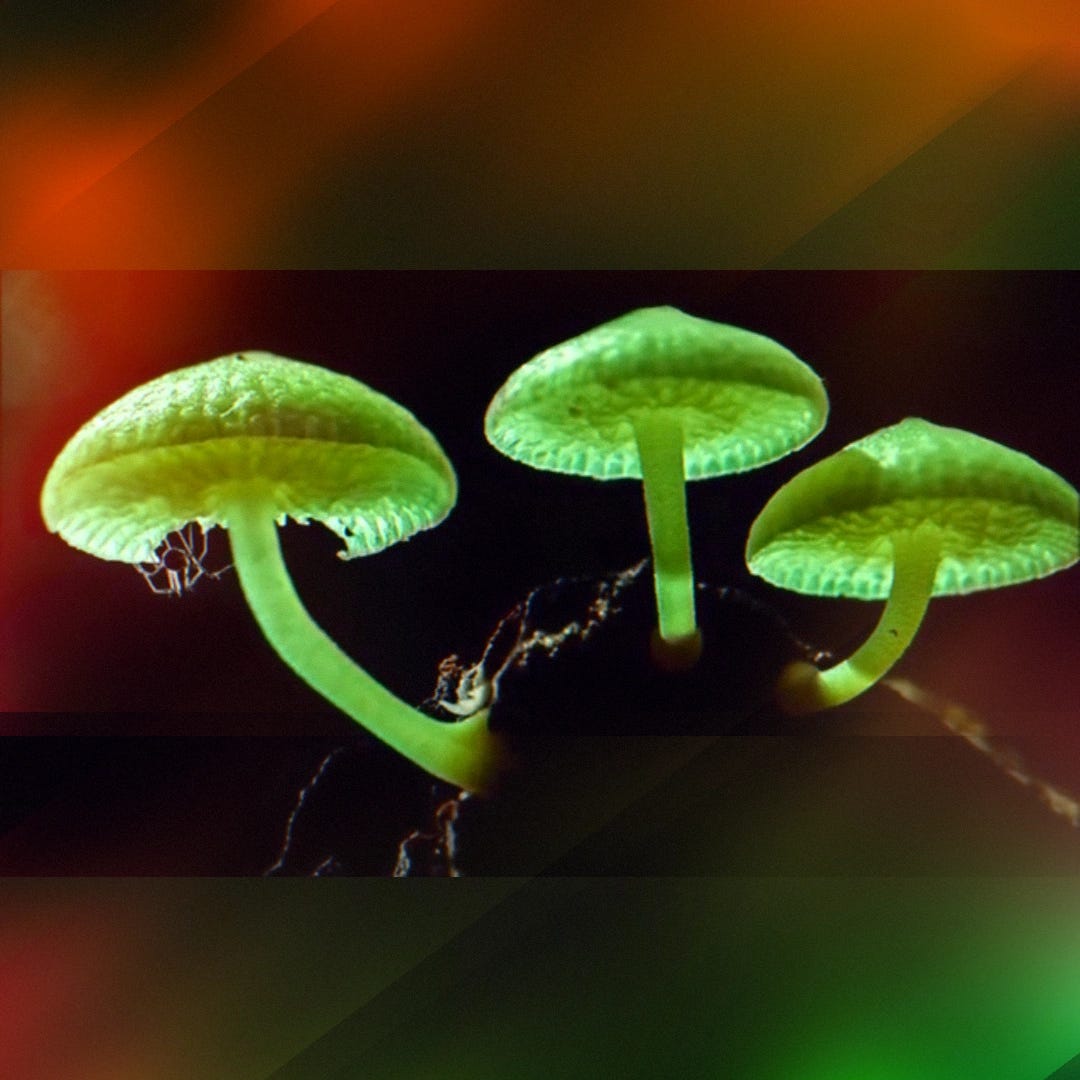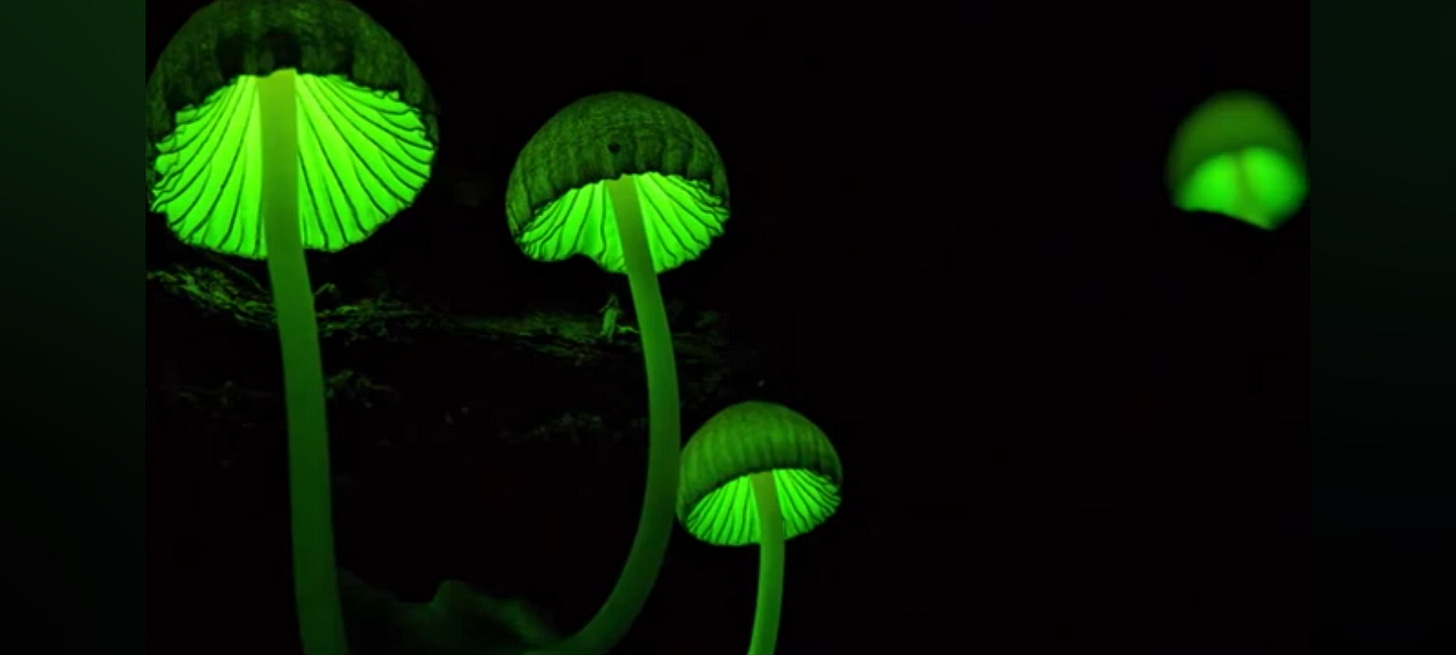I have to start by saying, I love everything about this name. Saying “foxfire fungus” is so satisfying. It’s a bit of a tongue twister and makes me think of the Tarantino film Pulp Fiction. The part when Uma Thurman’s character is talking about her brief stint in show biz, shooting a pilot for a series called Fox Force Five. It has the same ring to it.
I have a personal affinity for foxes. They are a woodland creature that is only seen when they want to be. And I’ve seen enough foxes grinning at me from the bushes to feel incredibly blessed.
Various mushroom species express foxfire. This is less a case study of one mushroom and more a mythological journey into the phenomenon of the luminous fungus. Jack-o-lanterns, ghost fungus, moon night mushroom and various honey mushrooms exhibit the glow. Not all parts of the mushroom glow. In some it is only the cap or gills, in others, only the stem. In still others it is the mycelium that will turn an entire standing dead tree into an Avatar-esque wonderland. Mycena, Omphalotus, Panellus and Armillaria are among those most commonly found lighting up the deep woods.
Why do they glow?
Data suggests that some glow to attract nocturnal animals to aid in spore dispersion. This is a special adaptation in closed canopy forests where wind dispersal is hindered. Others glow to attract the natural enemies of insects that eat them – befriend the enemy of your enemy. And some, in true fungal style, glow for reasons as yet unexplained by this planet’s most curious species (that’s you and me, my fellow humans).
Only around 130 species in the known fungal kingdom express bioluminescence. But that number has doubled in the last 5 years. This is what I love about mushroom world: how much there is yet to know.
All which glow form thin-walled white spores for dispersal, and all are white rot fungi - the ones who’ve devoted themselves to breaking down trees. Without them, cellulose would stay stuck in solid form, which would impact the carbon cycle and alter life on earth as we know it.
The phenomenon has been observed since ancient times. Aristotle’s notes refer to a light that, unlike fire, felt cold to the touch. Unflatteringly, he called the observance glowing, rotting tree bark. We can forgive him as he didn’t comprehend that it was an exalted member of Kingdom fungi to whom he referred. Most importantly, he asked the question that catalyzed that all important spark of inquiry that led to me sitting here writing to more inquiring minds about the glowing fungal phenomenon - Why?
He’s not the only one who pondered and put that pondering down in ink. In Naturalis Historia Pliny the Elder described many bioluminescent organisms. The treatise includes detailed descriptions of glowworms, fireflies, the luminous mollusc Pholas dactylus, the purple jellyfish Pelagia noctiluca, the lantern fish, and a dawning description of luminous mushrooms when he details glowing wood in olive groves.
A Dutch physician in the 17th century noted that Indonesian natives used glowing wood as wayfinders when traveling at night. Many explorers and citizen scientists through the ages include at least an honorable mention of the mysteriously glowing organisms they encountered in their travels. More than one ship captain's log speaks of flaming seas. Many think that the Chinese origin myth which describes fire being born from the sea was born of the imaginations of people witnessing bioluminescent plankton creating their cool light.
Its source was captured from the realm of myth into a scientific study in 1823 – an investigation spurred by wonder at wooden beams emitting light in the black depths of a mine. Upon closer inspection, the source of light revealed itself as a fungus. More accurately, microscopic examination determined with certainty that fungal threads growing on wood were the origin of the light. This discovery allied centuries of bioluminescence research with the terrestrial world of mushrooms.
Of oceanic species, the majority can be said to produce some kind of luminescence. But on land, a mere handful.
As if creating your own light wasn’t cool enough, foxfire was also used to illuminate the barometer and compass of Turtle, an early submarine. Learning this, I got excited about the idea of deep-sea fungus, only to uncover that cold temperatures experienced in the ocean’s depths rendered the enzyme responsible for mushroom luminescence inactive, so the submarine’s makers had to return to the drawing board.
The land-lubbing molecule that didn’t like its deep-sea adventure is called luciferin, which emits light upon oxidation catalyzed by the enzyme luciferase. We know that oxygen is necessary for the reaction from a series of experiments with other bio-luminescing organisms. It was observed that fireflies stopped emitting light when air was removed from their chambers.
This reaction creates an excess of energy which is released as light. But it would also require a lot of biological energy from the mushroom to create this reaction, so firstly it must have a function and second, it must have a way to meter the energy it spends, right?
Turns out, the endlessly impressive fungal intelligence uses a temperature regulated circadian clock to know when to glow. They glows brightest when the spores are reaching maturation. This observation led to rigorous testing of the theory that they glow to attract insects to help them colonize fallen trees who need help returning to the earth.
Multiple experiments have shown that certain insects are attracted to the mushroom’s glow. They deduced this using dupe mushrooms lit with LEDs that emit the same frequency of light as the fungus. They doused them in a sticky resin, placing them alongside controls like non-glowing mushrooms. Arthropods were consistently found more frequently stuck on the lit mushrooms than on the unlit controls.
What’s so Foxy about Mushrooms
The name is evocative, bringing to mind foxes sitting fireside, foxes with flames licking up their tails, Quentin Tarantino films, web browsers, did I miss any? Foxfire may derive from the old French word faux, rather than the name of the animal. This name would certainly make sense if someone had felt deceived by a glowing log that was not on fire.
The association of foxes with mystical fires is widespread. In Finnish, the name for the Aurora Borealis is Revontulet, which translates to “fox fires”. The name derives from a Finnish myth that depicts the northern lights as sparks from the snow swished up by the tail of a magical fox. This mythical fox is known as Tuliketta, or Firefox. So named because by day his coat is as black as the night sky, but after sunset the tips of his fur glow with otherworldly light. The grain of truth in this myth is that static in the tips of a fox’s fur would create sparks as they brushed up against trees and snowbanks on a dry winter’s night. If you happened to lay eyes on an arctic fox at night, well I imagine that pure white coat would reflect any light source in a very awe-inspiring way.
In Japanese folklore, the firefox is known as Kitsune. They appear as ordinary foxes at first, but evolve to become shapeshifting, color changing, tail acquiring magicians. Nineties kids who played Sonic the Hedgehog might recognize his sidekick, Tails, as a kitsune inspired character. The hint is in his multiple tails. Every hundred years, kitsune grow a new tail. On their hundredth birthday, they achieve the ability to shape-shift. As they progress, their fur changes from red to gold and finally to white when they receive their ninth tail and transcend to immortality.
In their time as mere mortals, they spend it causing mischief. How else would a fox spend its time? They take the form of beautiful women to play with the hearts of men, or old priests to win the trust of humans before wreaking havoc on their beliefs. They can remain in human form for long stretches of time, even raising children with human spouses.
It would get old pretending to be human in a life that spans a millennium. Kitsune have also been known to take the shape of giants, of monsters, of impossibly tall trees and mountains, or even, of a second moon in the sky. Japanese author Haruki Murakami wrote an epic novel in which the character knows she’s in another world by the second moon in the sky. Anything is possible in this world, strange things happen. She can alter reality just by thinking differently. Perhaps she was touched by kitsune. I highly recommend reading IQ84. It’s rich with Japanese geography, folklore, mythology, food and culture.
Other appearances of kitsune in modern tales occur in The Fox Woman by Kijima Hideo, a novel that portrays the life of a Kitsune in female form as she navigates human society, and a manga series Inu Yasha by Rumiko Takahashi in which a Kitsune called Shippo aids the protagonists.
In the past, mental illnesses or a person acting strangely have been attributed to possession by kitsune. These disorders are known as kitsunetsuki. Generally, it’s people acting bestially, absurd and wild.
A familiar myth by now - mysterious lights in the sky are said to be caused by kitsune magic. Like the Finnish, the Japanese word for aurora it is kitsunebi, which you might have guessed, translates to fox fire.
Interactions between our species and theirs are widely documented if you need some playful reading material. I’ll include here one particularly relevant tale, retold as I understood it:
A fishing village that was entirely dependent on the whims of the sea had no choice but to live in harmony with the natural cycles. They were unable to take too much, but if they remained grateful for what they had, there would always be enough.
One fisherman who, try as he might, couldn’t seem to fish or to keep enough to support his family falls on hard times when his boat is damaged in a terrible storm. Surrendering to the power of nature, he presses his head to the soaked earth to pray for assistance.
When he raises his head, he notices a glimmering fox sitting atop a grassy hill. He knows that the fox spirit rewards hard work, resilience and devotion. He sets to work. Returning day after day to repair his boat, he sees the fox continually and it grows brighter and more eye catching with each day. When his boat is ready, the fox approaches him and drops a fish at his feet. A reward, and a bargain: If the fisherman can promise to honor balance and respect all of nature, he will be rewarded with a great abundance of fish to use as he wishes. But he must use his bounty wisely, or it will be taken away.
He accepts the bargain and sets off atop the ocean. Every day his nets are teeming with fish and his family grows healthy and wealthy. He gives back to his community, and they join him in health and wealth.
He makes offerings every day at the shrine of Inari (deity of the harvest) and if, in illness or neglect, he misses a day, his nets will be empty until he resumes his offering. The year he chose not to donate his customary barrels of salted fish to the harvest feast, his whole year was plagued by empty nets that flapped in the wind.
On the final day of this year, he pulled up the net feeling it heavy with a catch. He grew excited, thinking he had bested the system. But instead of a bounty of squirming fish, his net had captured a cheekily smiling fox who transformed into a shark, bit through the net and swam away.
He learned his lesson and from that day forward, made sure to share his abundance with his community and give thanks to the spirits of nature that give him wealth.
If you suspect you may be the play toy of a kitsune look for a few giveaways. Most obvious would be their bottle brush tail of red or gold peeking out from beneath robes and coats. Should they be clever enough to keep their backside hidden from your probing eyes, look for the tell-tale glow of their Hoshi no Tama, their Soul Ball. They must keep this iridescent gem with them at all times for it contains their soul. Without it they will lose their shapeshifting powers and their ticket to immortality. They will wither and die.
While popularly portrayed as tricksters and sometimes even malevolent forces in the lives of those deserving punishment, they are also often benevolent and the bearers of divine reward. These noble foxes are known as inari kitsune as they serve the Shinto deity Inari. Legends tell of these celestial foxes granting wisdom and material reward to good and pious humans, especially those that rescue disguised kitsune or respect the divine nature of all existence. They can be protective forces, guiding worthy humans through danger and bringing luck to those graced by their presence.
They can transform the world around them, creating cathedrals out of abandoned factories, palaces out of burnt trees, peaceful gardens out of wastelands. These magic foxes are beginning to sound a lot like mushrooms.
To this day, Kitsune hold a special place in Japanese folklore, spirituality, literature, anime, manga, and video games. Their enduring relevance can be attributed to the same significance that tales like Star Wars and Lord of the Rings will hold for every successive generation in that they playfully remind us of the ever-present battle between good and evil in our own souls.
How I Met Them
I first encountered them while frolicking at a festival that I help put on – a hidden gem in Alberta called FrogFest. The land we held it on for a decade was host to fireflies, so attendees were no strangers to watching nature’s spectacle of organic light.
I was standing by the stage when a group of wild-eyed friends ran up to me breathless and excited (remember what I said about mushroom people being enthusiastic). Judging from the size of their pupils, these folks were under the influence of another mystical mushroom. They bade me to follow them.
My curious nature beckoned me away from the brightly illuminated stage where rock music pumped its rapid rhythms. We embarked into the forest, pulsating with a different rhythm.
Laughingly, they led the way. The mood was one of anticipation, punctuated with joviality. One girl said she immediately thought of me when they stumbled upon this treasure. Another said “there’s no way this is real”. She’s worried I won’t believe it until I see it. Which must be the reason they haven’t told me what “it” is.
The fella that’s with them threw his head back and laughed at the sky. He said he’s been looking for evidence of bioluminescent mushrooms a long time and has finally found one in the flesh. A hint!
As we approached the place of their discovery, they began speaking in hushed tones.
“It’s near here, “ one of my guides whispered.
“Are you sure?” responded another.
“Turn off your flashlights,” said the third.
In the moment it took our eyes to adapt to near total darkness I began to question my sanity at following these folks out here instead of enjoying the music that I helped curate. I could still hear the music from the stage but it sounded garbled through the dense woods. I wondered if I should turn back.
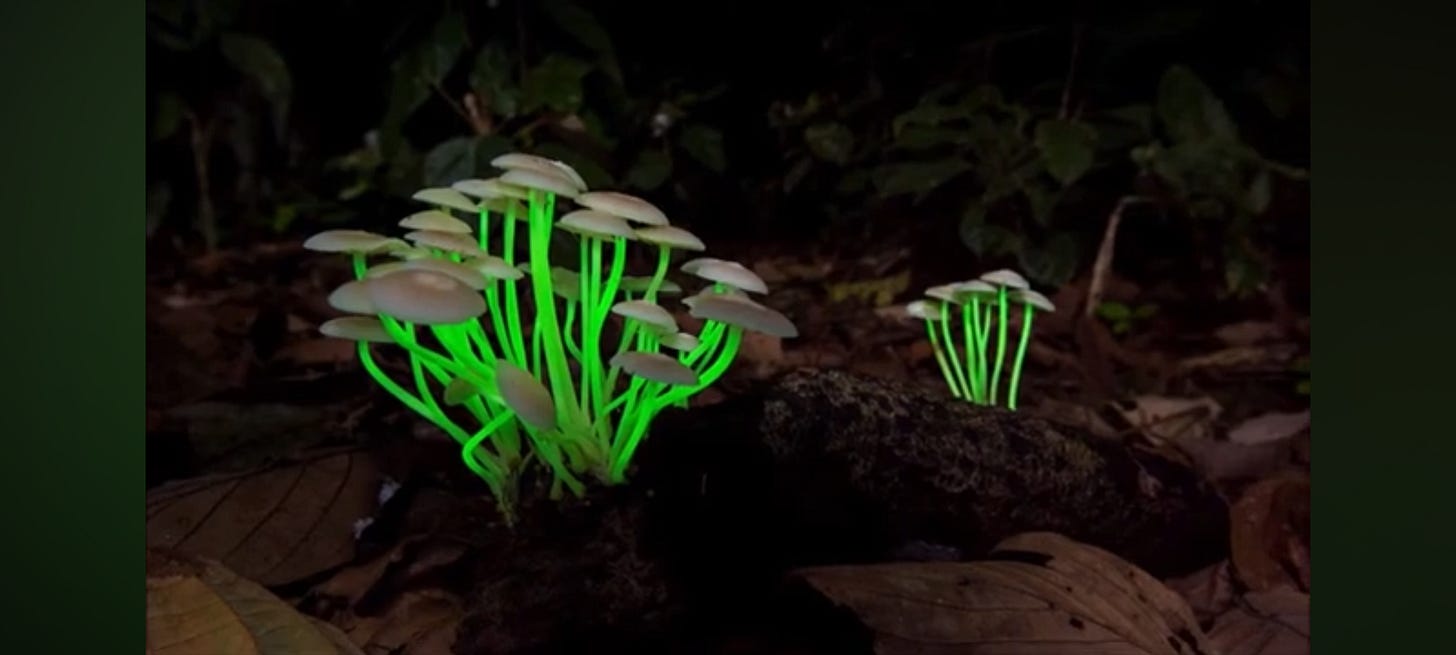
And then, wavering before us with the phantom presence of a dream stood a vision which sparked folklore of spirits and mystical foxes, of deceitful fey and protective presences across the globe.
It appeared as though a dozen or so tall, slender beings held council in the clearing that slowly took shape before my eyes - if those beings had been painted with moonlight. But there was no moon that night. Through the screen of alder leaves they seemed to dance and sway.
I approached one of the pillars of light and it bent toward me. Must’ve been a trick of the light. I reached out to it and the pale skin of my arms began to glow. An instant before touchdown, I felt a pulse of electricity. An acknowledgement of presence. And then I pressed my palm to cool tree bark, rough and flaking beneath my fingers.
The luminous ones were not alien visitors or mystical beings of lore, but standing dead trees inoculated with a bioluminescent fungus. Knowing this made it no less wondrous. It transported me to imaginal realms, standing alongside my ancestors as they wandered a dark forest at night. Feeling their steps falter as they encountered these beings lit with internal light. Walking beside them as they moved toward what they thought was a safe harbor for the night – the lit window of an inn, a bed and a warm meal. Stopping dead in awe as they found themselves instead among trees slowly decomposing in rays of light.
In realms where Celtic belief proliferated, the will o the wisp walks hand in hand with myths about luminescent lifeforms. The glow of a lantern held by a being who moves with otherworldly agility would lead travelers astray. The lost one was said to have gotten bested by the will o the wisp. The glow they went chasing could have been a fairie flame in the twilight, or perhaps it was a firefly, or a radiant weave of luminescent mycelium, perhaps the eerie glow came from bacteria in the swamps where the traveler was drowned.
In any case, such stories were warnings to travelers. Firstly, to know where one is going. Secondly, to travel by day. And third, to avoid such luminescent enticements, lest they invoke the mischievous fairies’ whimsy. They warn you to plan ahead, to map your route. The triumph of reason over mysticism. And yet, as a child of the age of information, the supposed height of reason, here I am awe struck by a cluster of glowing stumps.
How You Can Meet Them
Best time to see the magic in action is late summer to early autumn when the mushrooms are likely to be mature and sporulating. Of course, you’ll want to be out in the woods at night.
I know what you’re thinking, any sane person would be in a well-lit home after nightfall. I get it, it's spooky alone. Plus, our well-developed evolutionary code tells us to seek shelter as darkness creeps in. You’ll have to over-ride the code for a night or two. It'll be worth it!
Take some friends with you, set up camp and do some daytime reconnaissance. You’re looking for standing dead or fallen tree bodies that have turned white and pulpy from the colonization of saprobic fungus.
You’ll want to sit out of doors as dusk sets in. This will help your eyes adjust slowly and you’ll be able to make out more than just shapes. Have patience with your vision. I plunged myself into darkness from a well-lit stage and my eyes adjusted in time.
Many modern humans won’t like this - you can carry a flashlight with you, but avoid using it unless you encounter some sketchy terrain.
Wander around the darkened woods and with a sweeping gaze, see if you can spot a light emanating from a source other than your fire. It may take a few outings. Don’t give up hope. Remember that we live in a magical world where mushrooms glow!
Sources consulted:
Cell Press. "Some mushrooms glow, and here's why." ScienceDaily. ScienceDaily, 19 March 2015. <www.sciencedaily.com/releases/2015/03/150319123956.htm>.
Lee, John. (2008). Bioluminescence: the First 3000 Years (Review). Biology. 3. 10.17516/1997-1389-0264.
Foxfire and fungi: Solving a 2,300 year-old mystery - The University of Chicago Library News - The University of Chicago Library
Sivinski, John. (1981). Arthropods Attracted to Luminous Fungi. Psyche. 88. 10.1155/1981/79890.



